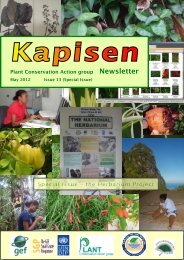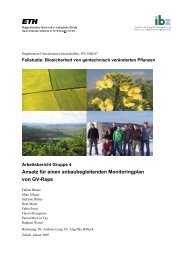Kapisen - ETH Zürich
Kapisen - ETH Zürich
Kapisen - ETH Zürich
Create successful ePaper yourself
Turn your PDF publications into a flip-book with our unique Google optimized e-Paper software.
S a v i n g R a r e P l a n t s<br />
Fig. 2:The caterpillar of the Common Striped Hawkmoth<br />
(J Mougal).<br />
seedlings, at least 7 plants must have died. Out of the<br />
relocated plants that were still labeled with a metal<br />
tag only one increased its height considerably (from<br />
23 to 84 cm). In all groups, herbivory damage was<br />
found on a few plants. Some plants were growing in<br />
between a recently fallen Jambrosa tree (Syzygium<br />
jambos) and the whole population was surrounded<br />
by the invasive Christmas tree (Ardisia crenata).<br />
From our survey we can conclude that adult mortality<br />
in the field seems to be high, and that reproduction,<br />
probably vegetatively, is happening. Flowering<br />
and fruiting occurs but not much is known about<br />
pollination. The long spur of the flower suggests that<br />
long-tongued insects such as hawkmoths are possible<br />
pollinators. The plants seem to suffer from attacks by<br />
generalist herbivores (Common Striped Hawkmoth,<br />
Pachnodus snails, slugs). The populations are<br />
surrounded by invasive shrubs (especially the<br />
Christmas tree Ardisia crenata) and invasive trees<br />
(e.g. Syzygium jambos, Paraserianthes falcataria).<br />
All known Belzamin sovaz plants were found within<br />
15 meters, and each of the three groups covers no<br />
more than a few square meters. So, a single large<br />
falling tree may destroy a major part of the remaining<br />
population.<br />
It is highly questionable whether this population of<br />
Belzamin sovaz in a disturbed secondary forest,<br />
almost completely dominated by invasive species,<br />
will survive in the long term, even after reinforcement.<br />
Also, the accessibility of the population is difficult and<br />
therefore management costs are high.<br />
At the moment there are only three known individuals<br />
of the Trois Fréres population in ex situ collections<br />
in Seychelles. The first priority is to reproduce<br />
more individuals from the remaining plants of the<br />
Trois Fréres population in nurseries. Secondly, a<br />
search should be initiated in private gardens in the<br />
Seychelles, for Belzamin sovaz plants known to<br />
derive from the Trois Fréres or one of the extinct<br />
Mahé populations. No plants from the Silhouette<br />
population should be reintroduced to Mahé as long<br />
as the population genetics of Belzamin sovaz is not<br />
better known.<br />
Morne Blanc has been suggested as an alternative<br />
re-introduction site on Mahé. From historical records<br />
it is known that Belzamin sovaz has grown there<br />
in the past. The site is easily accessible, and the<br />
vegetation is still relatively undisturbed. After the<br />
re-introduction, the first priority should then be the<br />
monitoring of herbivore attack, and the identification<br />
of pollinators.<br />
Field monitoring of <strong>Kapisen</strong> (Northea hornei)<br />
Other on-going fieldwork that has been taking place<br />
over the past 7 years is regular monitoring of the<br />
natural regeneration of <strong>Kapisen</strong> (Northea hornei)<br />
in the Mare aux Cochons valley (430 m altitude,<br />
Morne Seychellois National Park). The monitoring<br />
programme came about when we noticed a high<br />
abundance of <strong>Kapisen</strong> seedlings and saplings<br />
beneath a mother tree (256 individuals per 95 m 2 ;<br />
max. density in one cluster: 85 ind. / 20 m 2 !) during<br />
a reconnaissance of the area. It was an unusual<br />
sighting since most of the time we observed around<br />
15 to 40 seedlings or saplings beneath an adult tree<br />
(Fig. 4).<br />
The monitoring started in July 1997. All saplings<br />
(>50cm,







